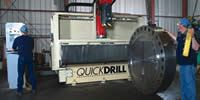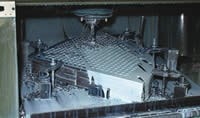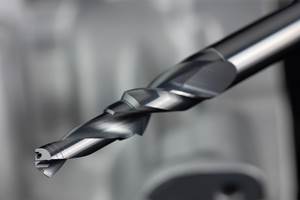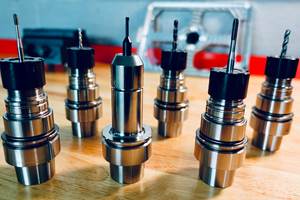New Drilling Process Helps Manufacturer Expand
Planning to expand its services in the high-quality, high-pressure end of the heat exchanger market, this long-tim manufacturer started the search for new high speed drilling machines to advance its technology and improve quality and response time.
The Ohmstede name has been part of American manufacturing for almost a century. In 1905, German immigrant August Ohmstede established a small job shop in Beaumont, Texas. In the 1940s, Ohmstede began repairing shell and tube heat exchangers for the booming local refinery industry.
By the mid-1980s, Ohmstede was the dominant market force for the manufacture of tube sheets (the main components used to isolate essential fluids in heat transfer equipment). Today, with 550 employees at five plants throughout Texas and Louisiana and 1 million billable hours per year, Ohmstede Ltd. continues to position itself for the future.
Part of this positioning, according to Ohmstede president Bill Reid, is setting the standard in responsiveness for the repair and manufacture of heat exchanger components used by the oil and chemical industry located along the Gulf Coast.
“In our industry, there is an extremely short window when a refinery shuts down to do a turn-around,” states Mr. Reid. “The customer needs to know we have the capacity to do the work and quickly help them get back in production.”
Prior to 1995, the company focused on serving a world market. However, with the competitive challenges from the Far East—including issues such as subsidized steel and labor rates—Ohmstede, like many American manufacturers, has strengthened its offerings closer to home.
Case in point: Ohmstede recently expanded its field service operations to provide “blind to blind” heat exchanger services. This service involves dropping the head (or blind end) on a heat exchanger, removing the bundle, then transporting it to an Ohmstede facility for repair work or the manufacture of a replacement bundle. To implement this time-sensitive service, the company had a mandate to streamline its manufacturing processes.
To increase production capacity, Ohmstede began developing centers of excellence in all of its facilities. As part of the plan, the 90,000-square-foot plant in Beaumont was slated to become the company’s main force in drilling production. In effect, the Beaumont facility would act as a vendor to the other Ohmstede plants, operating 24/7, using streamlined processes and machinery to manufacture the majority of tube sheets and baffles required by its customer base.
In 2001, the Beaumont plant was outfitted with 12 CNC drilling centers, consolidated from the company’s total CNC fleet of 30 regional machines. Planning to expand its services in the high-quality, high-pressure end of the heat exchanger market, Ohmstede started the search for new high speed drilling machines to advance its technology and improve quality and response time.
In 2002, the search ended with the purchase of two 96-inch by 96-inch CNC Quickdrills manufactured by Quickmill Inc. Says Mr. Reid, “A large part of our focus is being able to turn product around to our customers very quickly. That is one of the reasons we went after the Quickdrill.” After research into high speed drilling machinery and technologies, the Quickdrill model emerged the frontrunner in carbide tooling capability, ease of operation, accuracy, maintenance and setup.
Tom Bobino, plant manager of the Beaumont facility, says that the decision to purchase two Quickdrills was strategic. Ohmstede staff created a footprint on the shop floor that placed the two Quickdrills side by side with mirrored control panels. “Our objective was to have one operator control both machines from one workstation,” says Mr. Bobino.
Quickmill Inc. worked with the Ohmstede team to develop panels with right and left-hand controls. The two companies also collaborated on other factors, such as optimum chip removal processes and the proper sequencing of the Quickdrill machines within the production process.
With the introduction of both Quickdrills, delivered just 2 months apart, Ohmstede’s drilling capacity immediately expanded in scope and scale. Each Quickdrill is capable of drilling designated patterns of holes in tube sheets ranging in thickness from 3/8 inch to 12 inches. The largest tube sheets measure 120 inches in diameter, and many require 5,000 or more holes. Mr. Bobino says the Quickdrill is suited for carbon steel plates that are typically 4 to 6 inches thick. He adds that, routinely, they are able to drill 500 holes at 25 inches per minute using carbide tooling before changing tools.
The ability to use carbide tooling enables better precision, finishing each hole on the machine. Prior to the two Quickdrills, the process involved using a CNC drill and then transporting each workpiece to a radial drill to complete reaming, ring grooving and deburring processes.
“With the Quickdrills, 90 percent of all operations can be performed on a tube sheet before the part comes off the machine,” says Mr. Bobino. He says that in the past, only 40 percent of the work was completed on CNC machines. The Quickdrill’s finishing capability—combined with the ability to drill deeper holes and maximize speed and feed rates—has meant a 30 to 40 percent increase in productivity on the majority of workpieces.
Both Quickdrills have been operating 20 to 24 hours per day since September 2002. Since the in-house maintenance training offered by Quickmill, Ohmstede has had good results with both machines.
“Everybody talks about how well these machines do on bigger items, but one thing that always impresses me is the Quickdrill’s ability to also drill the smaller tube sheets,” says Joey Peno, repair manager at the Beaumont plant. “It’s pretty amazing the volume these machines can turn out.”
Maintaining Ohmstede Ltd.’s history means looking into the future. Production team members at Ohmstede plan to continue working with Quickmill Inc. and the carbide drilling manufacturers to refine their hole drilling processes—focusing on drilling even deeper holes to a finished size faster and at less cost per hole. The Quickdrills give Ohmstede the platform on which to perform the work.
“When we launched this expansion program, we wanted to work with a company that would allow us to standardize on a specific type of machine tool,” says Mr. Reid. “With the talent we have in house, and the support of companies like Quickmill, Ohmstede is ready for the future.”
Related Content
How to Tackle Tough Angled Pocket Milling With Two Tools
Milling a deep pocket with a tight corner radius comes with unique challenges, but using both a flat bottom drill and a necked-down finishing tool can help.
Read MoreEmuge-Franken's New Drill Geometry Optimizes Chipbreaking
PunchDrill features patent-pending geometry with a chipbreaker that produces short chips to control machining forces.
Read MoreChoosing Your Carbide Grade: A Guide
Without an international standard for designating carbide grades or application ranges, users must rely on relative judgments and background knowledge for success.
Read MoreHow Lowering Torque Improves Tapping Tool Life
Escaping the tap breakage trap requires a long look at torque and the many factors that influence it.
Read MoreRead Next
The Cut Scene: The Finer Details of Large-Format Machining
Small details and features can have an outsized impact on large parts, such as Barbco’s collapsible utility drill head.
Read More3 Mistakes That Cause CNC Programs to Fail
Despite enhancements to manufacturing technology, there are still issues today that can cause programs to fail. These failures can cause lost time, scrapped parts, damaged machines and even injured operators.
Read More.png;maxWidth=970;quality=90)











.png;maxWidth=300;quality=90)















